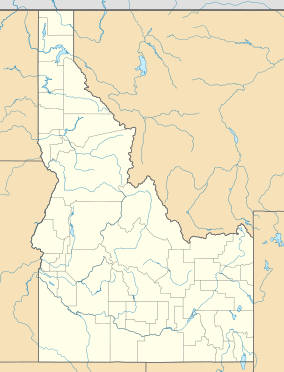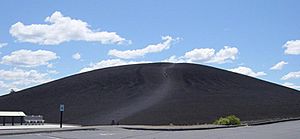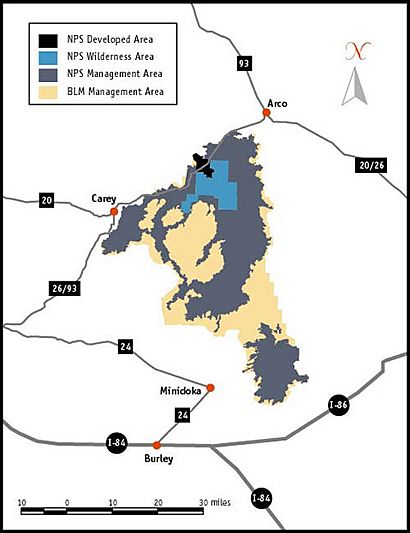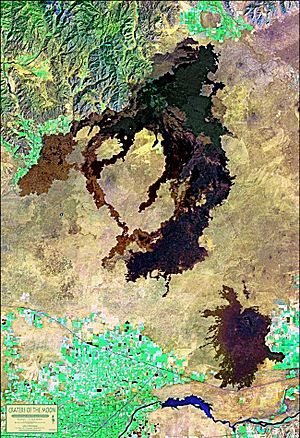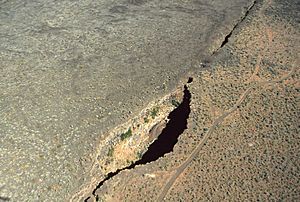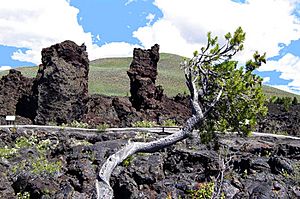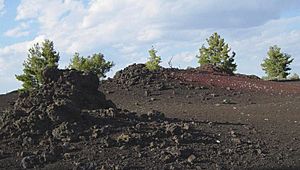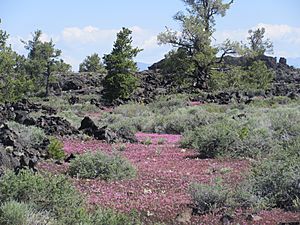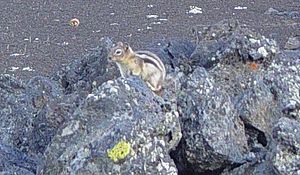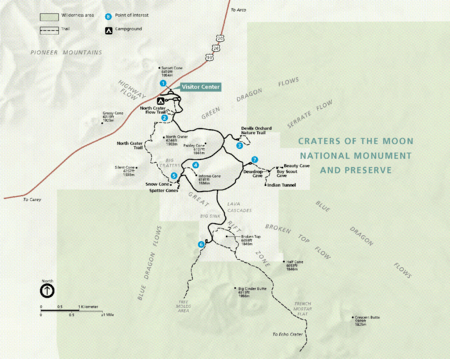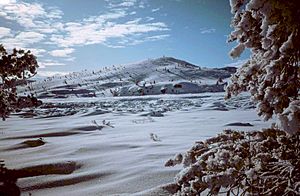Craters of the Moon National Monument and Preserve facts for kids
Quick facts for kids Craters of the Moon National Monument and Preserve |
|
|---|---|
|
IUCN Category V (Protected Landscape/Seascape)
|
|
 |
|
| Location | South Central Idaho, United States |
| Nearest city | Arco |
| Area | 753,000 acres (3,050 km2) |
| Established | Monument: May 2, 1924, Preserve: August 21, 2002 |
| Visitors | 246,826 (in 2015) |
| Governing body | National Park Service and Bureau of Land Management |
| Website | Craters of the Moon National Monument and Preserve |
Craters of the Moon National Monument and Preserve is a special place in central Idaho, United States. It's a U.S. national monument and national preserve that looks a lot like the Moon! You can find it along US Highways 20, 93, and 26, between the towns of Arco and Carey. The land here is full of amazing volcanic features. It's one of the best places in the United States to see ancient lava flows.
The Monument was first created on May 2, 1924. Later, in November 2000, its size was greatly expanded by President Bill Clinton. Then, in August 2002, the new parts managed by the National Park Service became the Craters of the Moon National Preserve. This huge area is now managed by both the National Park Service and the Bureau of Land Management.
The Monument and Preserve cover three large lava fields and about 400 square miles (1,000 km²) of sagebrush steppe grasslands. The total area is about 1,117 square miles (2,893 km²). The Monument itself covers 343,000 acres. All these lava fields are found along the Great Rift of Idaho. This rift has some of the deepest open cracks on Earth, reaching down 800 feet (240 m). You can see almost every type of basaltic lava here. There are also cool features like tree molds (holes left by trees burned by lava) and lava tubes (which are like natural caves).
Contents
What is Craters of the Moon Like?
Craters of the Moon is in south-central Idaho, between Boise and Yellowstone National Park. The main highway, US 20–26–93, goes right through the northern part of the monument. This makes it easy to visit. However, most of the monument is wild and undeveloped. Only one paved road crosses the northern end.
The Craters of the Moon Lava Field covers 618 square miles (1,600 km²). It's the biggest lava field in the United States that formed mostly in the last 11,700 years. The Monument and Preserve have more than 25 volcanic cones. These include amazing examples of spatter cones. The lava flows here are between 15,000 and 2,000 years old. The Kings Bowl and Wapi lava fields, which are about 2,200 years old, are also part of the National Preserve.
This lava field is the largest of many lava beds that erupted from the Great Rift. The Great Rift is a 53-mile (85 km) long crack in the Earth's crust. All these lava beds together make up the Lava Beds of Idaho. They are part of the much larger Snake River Plain volcanic area.
The area gets about 15 to 20 inches (380 to 510 mm) of rain and snow each year. Most of this water sinks into cracks in the lava. It then comes out later as springs in the Snake River Canyon. Older lava fields have plants like sagebrush. But younger fields, like Craters of the Moon, have very few plants. From far away, it looks like a black, empty land. The lava flows have also made the land higher, so it gets a lot of dry winds. This makes it hard for life to grow here.
Weather at Craters of the Moon
The weather at Craters of the Moon can be extreme. Summers are hot, with July temperatures often reaching 85°F (29°C) and sometimes over 100°F (38°C). Winters are cold, with December temperatures around 12°F (-11°C) and sometimes dropping to -37°F (-38°C). Snowfall is common in winter, especially in January and December.
History of the Area
Native American History
Paleo-Indians visited this area about 12,000 years ago. But they didn't leave much behind. The Northern Shoshone people made trails through the Craters of the Moon Lava Field. They used these trails during their summer trips from the Snake River to the camas prairie. They built stone windbreaks at Indian Tunnel to protect their camps from the strong summer winds. No one lived here permanently. The Shoshone were hunters and gatherers. They hunted large animals like elk, bears, American bison, cougars, and bighorn sheep. These animals don't live here anymore.
The last volcanic eruptions happened about 2,100 years ago. The Shoshone people likely saw them. A Shoshone legend tells of a giant serpent on a mountain. It got angry from lightning and squeezed the mountain. This made liquid rock flow, fire shoot from cracks, and the mountain explode.
Pioneer Trails
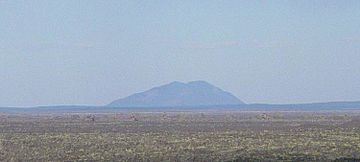
In the 1850s and 1860s, pioneers traveled in wagon trains on the Oregon Trail. Some used a different route in this area called Goodale's Cutoff. This route followed old Indian trails around the lava flows. It helped them avoid attacks from Shoshone warriors along the Snake River.
In 1862, a large group of immigrants asked a trapper named Tim Goodale to guide them through the cutoff. This group was very large, with 795 men and 300 women and children. They had a safe journey and named the cutoff after their guide. Goodale's Cutoff became a popular alternative route on the Oregon Trail.
Early Explorers and Scientists
In 1879, two cattlemen, Arthur Ferris and J.W. Powell, were the first known people to explore the lava fields. They were looking for grazing land for their cattle. But they found the area wasn't good for that.
In the 1800s, U.S. Army Captain Benjamin Bonneville visited the lava fields. He wrote in his diaries that it was a "desolate and awful waste, where no grass grows nor water runs."
Later, in 1901 and 1903, Israel Russell became the first geologist to study the area for the United States Geological Survey (USGS). He helped solve many mysteries about the lava beds. People in the 19th century said the area looked like the Moon. Geologist Harold T. Stearns gave it the name "Craters of the Moon" in 1923. He did this to help convince the National Park Service to protect the area.
Robert Limbert's Expedition
Robert Limbert, a man from Boise, explored the area in the 1920s. He heard stories from fur trappers about "strange things they had seen." He described the area as "practically unknown and unexplored."
Limbert went on several trips. His most famous trip was in May 1920 with Walter Cole and a dog. They explored the area from south to north. Limbert wrote that taking the dog was a mistake because "after three days' travel his feet were worn and bleeding."
Limbert wrote many newspaper and magazine articles about his trips. These articles made more people aware of the area. His most famous article was in National Geographic in 1924. He called the area "Craters of the Moon," which helped make the name stick. He wrote about the beautiful blue color of the Blue Dragon Flows at sunset:
It is the play of light at sunset across this lava that charms the spectator. It becomes a twisted, wavy sea. In the moonlight its glazed surface has a silvery sheen. With changing conditions of light and air, it varies also, even while one stands and watches. It is a place of color and silence...
Protecting the Land
Thanks to Limbert's work, President Calvin Coolidge made Craters of the Moon a National Monument on May 2, 1924. This was to "preserve the unusual and weird volcanic formations." Over the years, more land was added. In 1970, a large part of it became the Craters of the Moon National Wilderness. This protects the area even more.
From 1969 to 1972, NASA astronauts trained at Craters of the Moon. They were preparing for the Apollo program missions to the real Moon. They learned how to find and collect rock samples in a tough environment. They found that real Moon craters are mostly made by meteorite impacts, while the ones on Earth are from volcanic eruptions.
In 2000, the monument was expanded greatly to include the entire Great Rift zone. In 2002, the new parts became a national preserve. This allows some activities like hunting, which are not usually allowed in national monuments. Today, Craters of the Moon National Monument and Preserve is managed by both the National Park Service and the Bureau of Land Management.
How the Land Was Formed
The Snake River Plain is a volcanic area created by huge eruptions that started about 15 million years ago. Scientists believe a hotspot (a super hot spot deep in the Earth) caused this. This hotspot is now under Yellowstone Caldera in Yellowstone National Park. It was under Craters of the Moon about 10 to 11 million years ago. The hotspot stays in place, but the North American continent moves over it.
Heat left over from this hotspot created the many lava flows you see today. The biggest crack is the Great Rift. Craters of the Moon, Kings Bowl, and Wapi lava fields all came from this Great Rift. The Great Rift is so important it's a National Natural Landmark.
Even though the lava looks fresh, the oldest flows at Craters of the Moon are 15,000 years old. The youngest erupted about 2,000 years ago. Scientists believe the volcanoes here are just sleeping, not dead. They expect another eruption within the next 900 years, possibly even in the next 100 years!
The Kings Bowl Lava Field erupted about 2,250 years ago. This eruption probably lasted only a few hours or days. It left behind explosion pits and lava lakes. The Wapi Lava Field formed around the same time. It has low shield volcanoes. The Bear Trap lava tube is a cave system over 15 miles (24 km) long. It's famous for its length and well-preserved lava cave features. The lava tubes and pit craters here are special because they keep ice and snow well into the hot summer. This is because the sun can't reach them, and the lava acts like insulation.
A typical eruption here starts with a "curtain" of very hot, runny lava shooting up to 1,000 feet (300 m) high. As the eruption continues, the lava changes. It might form cinder cones (like Inferno Cone) or spatter cones. Sometimes, lava streams break out from the side of a cinder cone, carrying away large blocks of cinder. This is what you see at North Crater Flow and Devils Orchard. When lava flows harden on the outside but the inside flows away, it leaves behind lava tubes, which are like caves.
Plants and Animals
Surviving in a Harsh Land
Life at Craters of the Moon is tough! Plants and animals here face strong, dry winds and black lava that gets very hot. This heat quickly dries out living things. Summer soil temperatures can be over 150°F (66°C). Plants have to be very tough to survive.
Water is usually only found deep inside holes. So, animals get the moisture they need from their food. The black soil doesn't hold water well, making it hard for plants to grow. Plants often start growing in small cracks in the lava. The shaded north sides of cinder cones get less sun and wind. They also keep snow longer, which is a key water source. So, plants grow there first.
Some areas of older land are completely surrounded by newer lava flows. These are called kīpukas, a Hawaiian word. Carey Kīpuka is one such area. It helps scientists study how plants have changed over time.
Plants of the Lava Fields
There are 375 different kinds of plants known to grow in the monument. When wildflowers aren't blooming, you'll mostly see pine trees, cedars, junipers, and sagebrush. Plants here have special ways to deal with the dry, hot conditions:
- They can handle dehydration or pull water from very dry soil. Examples are sagebrush.
- They avoid drought by having small, hairy, or juicy leaves to save water. Like the hairs on scorpionweed or the juicy parts of the pricklypear cactus.

- They grow in small cracks or near water, or they stay dormant for most of the year. Mosses and ferns grow near water sources like ice caves. Some plants like dwarf monkeyflower complete their whole life cycle during the short wet season. They then survive as seeds the rest of the time.
A common plant here is the dwarf buckwheat. It's only 4 inches (10 cm) tall, but its roots can spread 3 feet (1 m) wide! This helps it get all the moisture in its area.
Wildflowers bloom from early May to late September. Snow-melt and spring rain help them grow. Most of these plants finish their life cycle in just a few months. By autumn, only the tiny yellow flowers of sagebrush and rabbitbrush remain. Some wildflowers you might see are the arrow-leaved balsamroot, bitterroot, and wild onion.
Animals of the Lava Fields
Biologists have found 2,000 types of insects, 8 reptiles, 169 birds, 48 mammals, and even one amphibian (the western toad) here. Birds and small rodents are seen most often. Brown bears used to live here but are now gone.
Most desert animals are nocturnal, meaning they are active at night. This helps them avoid predators and the hot summer daytime temperatures. Nocturnal animals here include woodrats, skunks, foxes, bobcats, mountain lions, bats, and owls.
Animals active at dawn and dusk are called crepuscular. This light helps them hide from predators but is bright enough to find food. Crepuscular animals include mule deer, coyotes, porcupines, mountain cottontails, and jackrabbits.
Some animals are diurnal, meaning they are active during the day. These include ground squirrels, marmots, chipmunks, lizards, snakes, hawks, and eagles.
Many animals change their active times with the seasons. Snakes and lizards hibernate in winter. They are active during the day in spring and fall, but become crepuscular in the summer heat. Some animals, like ground squirrels, have a summer hibernation called estivation to avoid the hottest, driest times.
Several animals are found only at Craters of the Moon. Special types of Great Basin pocket mouse, American pika, yellow-pine chipmunk, and yellow-bellied marmot live nowhere else. Lava tube beetles and other cave animals are only found in the lava tubes of eastern Idaho.
Mule Deer
In 1980, a researcher named Brad Griffith studied the mule deer in the monument. He found that these deer have a unique way to avoid drought.
The deer arrive in the southern part of the monument in mid-April. By late summer, the plants are too dry to give them enough moisture. So, in late July, the herd moves 5 to 10 miles (8 to 16 km) north to the Pioneer Mountains. There, they find water from streams and shade in aspen and Douglas-fir groves. When it rains in late September, they return to the monument to eat bitterbrush. In November, snow sends them back to their winter home. This herd is very successful, with many fawns surviving.
The deer are more active at night to avoid the dry afternoon winds. In 1991, there were about 420 mule deer in the herd.
Fun Things to Do
You can explore the volcanic features by driving the Loop Drive, which is 7 miles (11 km) long. You can see Wildflowers, shrubs, trees, and animals by hiking on trails or stopping at viewpoints. For more challenging hikes, you can go into the Craters of the Moon Wilderness Area.
- The Visitor Center is where you start your adventure. It has displays, films, and information to help you learn about the area. Park rangers lead walks in the summer.
- North Crater Flow is a paved trail less than 1/4 mile (400 m) long. It crosses a lava flow that formed about 2,200 years ago. You can see different types of lava, like ropey (pahoehoe) and jagged (aa) lava. You'll also see huge blocks of rock that broke off the volcano.
- Devils Orchard is a group of large lava rocks that look like a strange orchard. They were once part of the North Crater volcano. A 1/2 mile (800 m) paved loop trail goes through this area.
- Inferno Cone Viewpoint is at the top of Inferno Cone. It's a short but steep hike up. From the top, you get an amazing view of the entire monument. You can see the Spatter Cones and the Great Rift. In the distance, you'll spot Big Cinder Butte, one of the world's largest cinder cones.
- Big Craters and Spatter Cones are right along the Great Rift. Spatter cones are formed by sticky lava blobs. Big Craters is a cinder cone complex that's a short hike up.
- Tree Molds is an area where lava flowed over a forest. The trees burned, but they left behind hollow casts in the lava. Some still show the shape of the bark! This area is about a mile (1.6 km) from the parking lot.
- Cave Area is the last stop on Loop Drive. It has several lava tube caves, including Dewdrop Cave, Boy Scout Cave, Beauty Cave, and Indian Tunnel. These caves formed when the outside of a lava flow hardened, but the inside flowed away. You need a free permit to enter the caves. Flashlights are a must, and head protection is highly recommended!
The Craters of the Moon Campground has 51 campsites. They have water, restrooms, and grills. Park rangers give evening programs in the summer. Camping lets you enjoy the park in the cooler evenings and mornings.
Kids can also earn an embroidered patch by completing the Lunar Ranger program!
For more adventure, you can go hiking in the Craters of the Moon Wilderness and Backcountry Area. These areas are wild and have few trails. Most hikers follow the Great Rift to explore volcanic features. If you plan to stay overnight, you need to register with a ranger. There's no drinking water in the backcountry, so bring plenty! It's best to avoid hiking in the extreme heat of summer or the cold of winter. Pets, campfires, and vehicles (including bikes) are not allowed in the wilderness area.
In winter, you can go skiing on the Loop Drive after it closes to cars. There's usually plenty of snow by January and February. You can also go cross-country skiing off the Loop Drive. But be careful, as there can be sharp lava and hidden holes under the snow.
![]() This article incorporates public domain material from websites or documents of the National Park Service.
This article incorporates public domain material from websites or documents of the National Park Service.
- Official websites:


